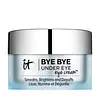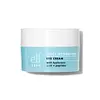What's inside
What's inside
 Key Ingredients
Key Ingredients

 Benefits
Benefits

 Concerns
Concerns

 Ingredients Side-by-side
Ingredients Side-by-side

Water
Skin ConditioningCyclopentasiloxane
EmollientButylene Glycol
HumectantButyrospermum Parkii Butter
Skin ConditioningDimethicone
EmollientNiacinamide
SmoothingCetearyl Alcohol
EmollientPEG-40 Stearate
EmulsifyingPalmitic Acid
EmollientStearic Acid
CleansingPolysorbate 60
EmulsifyingMacadamia Ternifolia Seed Oil
EmollientCetyl Ethylhexanoate
EmollientGlyceryl Stearate
EmollientGlycerin
HumectantAcrylates/C10-30 Alkyl Acrylate Crosspolymer
Emulsion StabilisingCarbomer
Emulsion StabilisingSodium Hyaluronate
HumectantAcetyl Hexapeptide-8
HumectantCopper Gluconate
Skin ConditioningCollagen
MoisturisingTea-Cocoyl Glutamate
CleansingPalmitoyl Pentapeptide-4
Skin ConditioningCopper Tripeptide-1
Skin ConditioningBiotin
AntiseborrhoeicCaffeine
Skin ConditioningMagnesium Aspartate
Skin ConditioningZinc Gluconate
Skin ConditioningSodium Ascorbyl Phosphate
AntioxidantSodium Lauroyl Lactylate
EmulsifyingCeramide NP
Skin ConditioningCeramide AP
Skin ConditioningPhytosphingosine
Skin ConditioningCholesterol
EmollientXanthan Gum
EmulsifyingCeramide EOP
Skin ConditioningRetinol
Skin ConditioningTocopheryl Acetate
AntioxidantAscorbic Acid
AntioxidantAloe Barbadensis Leaf Extract
EmollientAnthemis Nobilis Flower Extract
MaskingCurcuma Longa Root Extract
MaskingSqualane
EmollientSpirulina Platensis Extract
Skin ProtectingAlgae Extract
EmollientCucumis Sativus Fruit Extract
EmollientColloidal Oatmeal
AbsorbentPropylene Glycol
HumectantGlycyrrhiza Glabra Root Extract
BleachingCamellia Sinensis Leaf Extract
AntimicrobialLecithin
EmollientCaprylic/Capric Triglyceride
MaskingCreatine
Skin ConditioningSimmondsia Chinensis Seed Oil
EmollientVaccinium Angustifolium Fruit Extract
Skin ProtectingMaris Aqua
HumectantPanthenol
Skin ConditioningPolyglutamic Acid
Skin ConditioningMethionine
Skin ConditioningLysine
Skin ConditioningLeucine
Skin ConditioningHistidine
HumectantIsoleucine
Skin ConditioningArginine
MaskingDisodium EDTA
Polyacrylate-13
Polyisobutene
Polysorbate 20
EmulsifyingSorbitan Isostearate
EmulsifyingTromethamine
BufferingSorbitan Stearate
EmulsifyingBenzophenone-5
UV AbsorberCholesteryl Nonanoate
EmollientCholesteryl Isostearate
EmollientCholesteryl Chloride
Skin ConditioningPhenylalanine
MaskingThreonine
Valine
MaskingSaccharide Isomerate
HumectantTryptophan
MaskingElaeis Guineensis Butter
EmollientSorbitol
HumectantPolysilicone-11
Dimethicone/Vinyl Dimethicone Crosspolymer
Skin ConditioningPhenyl Trimethicone
Skin ConditioningCitric Acid
BufferingAlcohol
AntimicrobialPhenoxyethanol
PreservativeCaprylyl Glycol
EmollientEthylhexylglycerin
Skin ConditioningChlorphenesin
AntimicrobialPotassium Sorbate
PreservativeCI 42090
Cosmetic ColorantWater, Cyclopentasiloxane, Butylene Glycol, Butyrospermum Parkii Butter, Dimethicone, Niacinamide, Cetearyl Alcohol, PEG-40 Stearate, Palmitic Acid, Stearic Acid, Polysorbate 60, Macadamia Ternifolia Seed Oil, Cetyl Ethylhexanoate, Glyceryl Stearate, Glycerin, Acrylates/C10-30 Alkyl Acrylate Crosspolymer, Carbomer, Sodium Hyaluronate, Acetyl Hexapeptide-8, Copper Gluconate, Collagen, Tea-Cocoyl Glutamate, Palmitoyl Pentapeptide-4, Copper Tripeptide-1, Biotin, Caffeine, Magnesium Aspartate, Zinc Gluconate, Sodium Ascorbyl Phosphate, Sodium Lauroyl Lactylate, Ceramide NP, Ceramide AP, Phytosphingosine, Cholesterol, Xanthan Gum, Ceramide EOP, Retinol, Tocopheryl Acetate, Ascorbic Acid, Aloe Barbadensis Leaf Extract, Anthemis Nobilis Flower Extract, Curcuma Longa Root Extract, Squalane, Spirulina Platensis Extract, Algae Extract, Cucumis Sativus Fruit Extract, Colloidal Oatmeal, Propylene Glycol, Glycyrrhiza Glabra Root Extract, Camellia Sinensis Leaf Extract, Lecithin, Caprylic/Capric Triglyceride, Creatine, Simmondsia Chinensis Seed Oil, Vaccinium Angustifolium Fruit Extract, Maris Aqua, Panthenol, Polyglutamic Acid, Methionine, Lysine, Leucine, Histidine, Isoleucine, Arginine, Disodium EDTA, Polyacrylate-13, Polyisobutene, Polysorbate 20, Sorbitan Isostearate, Tromethamine, Sorbitan Stearate, Benzophenone-5, Cholesteryl Nonanoate, Cholesteryl Isostearate, Cholesteryl Chloride, Phenylalanine, Threonine, Valine, Saccharide Isomerate, Tryptophan, Elaeis Guineensis Butter, Sorbitol, Polysilicone-11, Dimethicone/Vinyl Dimethicone Crosspolymer, Phenyl Trimethicone, Citric Acid, Alcohol, Phenoxyethanol, Caprylyl Glycol, Ethylhexylglycerin, Chlorphenesin, Potassium Sorbate, CI 42090
Water
Skin ConditioningGlycerin
HumectantCaprylic/Capric Triglyceride
MaskingGlyceryl Stearate Citrate
EmollientJojoba Esters
EmollientDiisostearyl Malate
EmollientC10-18 Triglycerides
EmollientCetearyl Alcohol
EmollientSilica
AbrasivePalmitoyl Tripeptide-1
Skin ConditioningPalmitoyl Tetrapeptide-7
Skin ConditioningSoluble Collagen
HumectantSodium Hyaluronate
HumectantTocopherol
AntioxidantHelianthus Annuus Seed Oil
EmollientButylene Glycol
Humectant1,2-Hexanediol
Skin ConditioningPotassium Cetyl Phosphate
EmulsifyingPolysorbate 20
EmulsifyingPolysorbate 80
EmulsifyingIsohexadecane
EmollientSodium Acrylate/Sodium Acryloyldimethyl Taurate Copolymer
Emulsion StabilisingCarbomer
Emulsion StabilisingHydroxyacetophenone
AntioxidantDisodium EDTA
Water, Glycerin, Caprylic/Capric Triglyceride, Glyceryl Stearate Citrate, Jojoba Esters, Diisostearyl Malate, C10-18 Triglycerides, Cetearyl Alcohol, Silica, Palmitoyl Tripeptide-1, Palmitoyl Tetrapeptide-7, Soluble Collagen, Sodium Hyaluronate, Tocopherol, Helianthus Annuus Seed Oil, Butylene Glycol, 1,2-Hexanediol, Potassium Cetyl Phosphate, Polysorbate 20, Polysorbate 80, Isohexadecane, Sodium Acrylate/Sodium Acryloyldimethyl Taurate Copolymer, Carbomer, Hydroxyacetophenone, Disodium EDTA
Ingredients Explained
These ingredients are found in both products.
Ingredients higher up in an ingredient list are typically present in a larger amount.
Butylene Glycol (or BG) is used within cosmetic products for a few different reasons:
Overall, Butylene Glycol is a safe and well-rounded ingredient that works well with other ingredients.
Though this ingredient works well with most skin types, some people with sensitive skin may experience a reaction such as allergic rashes, closed comedones, or itchiness.
Learn more about Butylene GlycolThis ingredient is an emollient, solvent, and texture enhancer. It is considered a skin-softener by helping the skin prevent moisture loss.
It helps thicken a product's formula and makes it easier to spread by dissolving clumping compounds.
Caprylic Triglyceride is made by combining glycerin with coconut oil, forming a clear liquid.
While there is an assumption Caprylic Triglyceride can clog pores due to it being derived from coconut oil, there is no research supporting this.
Learn more about Caprylic/Capric TriglycerideCarbomer is a polymer of acrylic acid. Its main role is to create a gel consistency.
A high amount of carbomer can cause pilling or balling up of products. Don't worry, most products contain 1% or less of carbomer.
Cetearyl alcohol is a mixture of two fatty alcohols: cetyl alcohol and stearyl alcohol. It is mainly used as an emulsifier. Emulsifiers help prevent the separation of oils and products. Due to its composition, it can also be used to thicken a product or help create foam.
Cetearyl alcohol is an emollient. Emollients help soothe and hydrate the skin by trapping moisture.
Studies show Cetearyl alcohol is non-toxic and non-irritating. The FDA allows products labeled "alcohol-free" to have fatty alcohols.
This ingredient is usually derived from plant oils such as palm, vegetable, or coconut oils. There is debate on whether this ingredient will cause acne.
Due to the fatty acid base, this ingredient may not be Malassezia folliculitis safe.
Learn more about Cetearyl AlcoholDisodium EDTA plays a role in making products more stable by aiding other preservatives.
It is a chelating agent, meaning it neutralizes metal ions that may be found in a product.
Disodium EDTA is a salt of edetic acid and is found to be safe in cosmetic ingredients.
Learn more about Disodium EDTAGlycerin is already naturally found in your skin. It helps moisturize and protect your skin.
A study from 2016 found glycerin to be more effective as a humectant than AHAs and hyaluronic acid.
As a humectant, it helps the skin stay hydrated by pulling moisture to your skin. The low molecular weight of glycerin allows it to pull moisture into the deeper layers of your skin.
Hydrated skin improves your skin barrier; Your skin barrier helps protect against irritants and bacteria.
Glycerin has also been found to have antimicrobial and antiviral properties. Due to these properties, glycerin is often used in wound and burn treatments.
In cosmetics, glycerin is usually derived from plants such as soybean or palm. However, it can also be sourced from animals, such as tallow or animal fat.
This ingredient is organic, colorless, odorless, and non-toxic.
Glycerin is the name for this ingredient in American English. British English uses Glycerol/Glycerine.
Learn more about GlycerinPolysorbate 20 is made by combining ethoxylation of sorbitan, ethylene oxide, and lauric acid. It is a mild cleansing agent, surfactant, and emulsifier.
As a surfactant, it helps collect dirt and oils for washing. Emulsifiers prevent oils and water from separating.
Polysorbate 20 also adds scent to a product. Since it is made using sorbitol, it has a sweet scent. Sorbitol can also be found in fruits such as apples and peaches.
The lauric acid used to create Polysorbate 20 is often derived from coconuts.
Polysorbate 20 may not be fungal acne safe.
Learn more about Polysorbate 20Sodium Hyaluronate is hyaluronic acid's salt form. It is commonly derived from the sodium salt of hyaluronic acid.
Like hyaluronic acid, it is great at holding water and acts as a humectant. This makes it a great skin hydrating ingredient.
Sodium Hyaluronate is naturally occurring in our bodies and is mostly found in eye fluid and joints.
These are some other common types of Hyaluronic Acid:
Learn more about Sodium HyaluronateWater. It's the most common cosmetic ingredient of all. You'll usually see it at the top of ingredient lists, meaning that it makes up the largest part of the product.
So why is it so popular? Water most often acts as a solvent - this means that it helps dissolve other ingredients into the formulation.
You'll also recognize water as that liquid we all need to stay alive. If you see this, drink a glass of water. Stay hydrated!
Learn more about Water